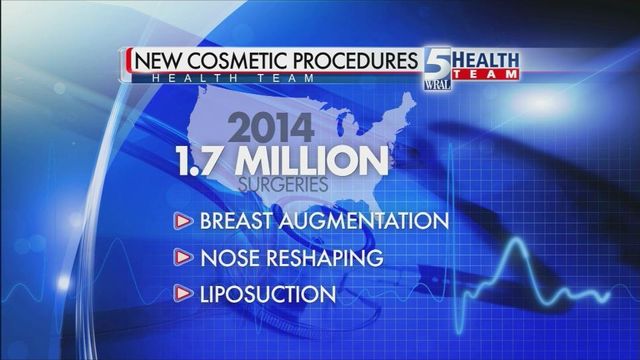Latest cosmetic surgery procedures are less invasive
When people don't like what they see in the mirror, some turn to surgery for help. Others try less invasive procedures.
Posted — UpdatedLast year, people in the U.S. underwent 1.7 million cosmetic surgical procedures, with breast augmentation, nose reshaping and liposuction leading the list, according to the American Society of Plastic Surgeons.
The most popular minimally invasive procedure in America is Botox, which freezes muscles that cause many wrinkles on the face. About 6.7 million Botox procedures were done in the U.S. in 2014 – a 6 percent increase from the year before.
Debbie Scully, who declined to share her age, said she got a Botox treatment earlier this year to look her best for her daughter's wedding. She came to Dr. Amy Fowler, a UNC ophthalmologist and oculofacial plastic surgeon, for help.
“By stopping the muscles from contracting, the overlying skin stops contracting,” Fowler said.
The second most popular, minimally invasive procedure is fillers, which replace fat lost due to aging. Injectable treatments to enhance the face are more popular than surgical face lifts, eye lifts and nose reshaping all put together.
Dr. Sue Ellen Cox, a dermatologist with Aesthetic Solutions in Chapel Hill, is on the cutting edge of injectable treatments. Her practice was a study site for a new injectable drug, Kybella, which targets neck fat.
“Using things like injectables can be used in a very balanced way where the patient has more control,” Cox said.
Catherine Bagchi, 40, of Chapel Hill, went to Cox to get help with her double chin.
“I just felt self conscious,” she said. “In photographs, I would always try to tilt my chin up to minimize the look of it.”
Cox says a double chin “isn’t something that you get just from weight gain. It can be a genetically predisposed factor, and it’s also something that patients can’t lose when they lose weight.”
To do the procedure, Cox uses a template to mark points under the chin where she injects the product, Kybella.
“It’s a natural product. It’s a bile salt,” she said.
Bile acid, which includes bile salt, is naturally produced in the liver. Bile salt helps dissolve fat in the intestinal tract. The company, Kythera, used bile salt, also called dioxycholic acid, in the form of an injectable drug called Kybella. Once it destroys fat cells, the cells can no longer accumulate and store fat.
Cox says most patients get the results they want in two to four sessions. Bagchi said she noticed her neck get smaller by the second session.
The final results take time. Side effects may include soreness and swelling for about a week. For four to six weeks, as the fat dissolves, there will be fibrosis, “which is a firmness that feels almost like little peas or marbles underneath the skin,” Cox said.
Trial results showed that once the firmness and fat faded away, participants with varying degrees of neck fat saw significant results.
Kybella is not FDA approved to use on stubborn abdominal fat. However, Cox's practice is a trial site for a new injectable drug to treat belly fat called LIPO-202 from the company, Neothetics.
“We see some patients who are very, very pleased with the results that they are seeing from that,” Cox said.
For several years, a non-invasive option called cool sculpting has been gaining popularity.
“(It’s) actually a freezing of the fat. It’s a 20 percent reduction in fat every time you get hooked up to this applicator,” Cox said. “And they actually have a new adapter for the neck, so it’s going to be a competitor for Kybella.”
Cosmetic procedures aren't covered by insurance. For Kybella, as with other procedures, the price varies from office to office. Cox charges $750 per vial of Kybella. Most people start with two vials at the first session, totaling $1,500. Three sessions would be $4,500.
The cost of liposuction varies anywhere from $2,500 to $4,000 and can be less expensive. However, procedures that use injections have fewer side effects and a faster return to work and normal activity.
In the past, board certified plastic surgeons were typically the only ones doing plastic surgery. But now, other specialists like dermatologists, ophthalmologists and otolaryngologists (ear, nose and throat doctors) are adding those options to their practices. Before getting plastic surgery, it is best to interview a couple doctors about their experience in doing the procedures.
• Credits
Copyright 2024 by Capitol Broadcasting Company. All rights reserved. This material may not be published, broadcast, rewritten or redistributed.





